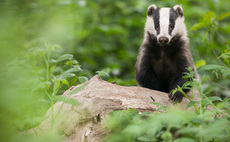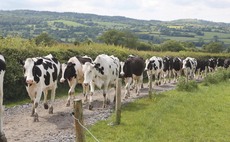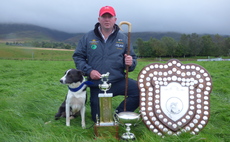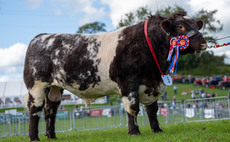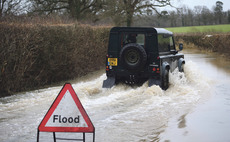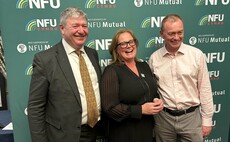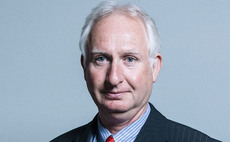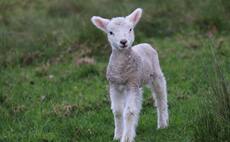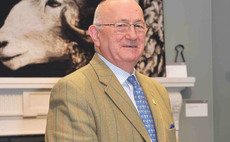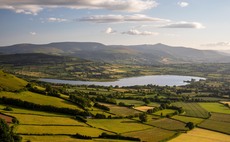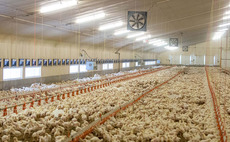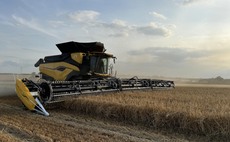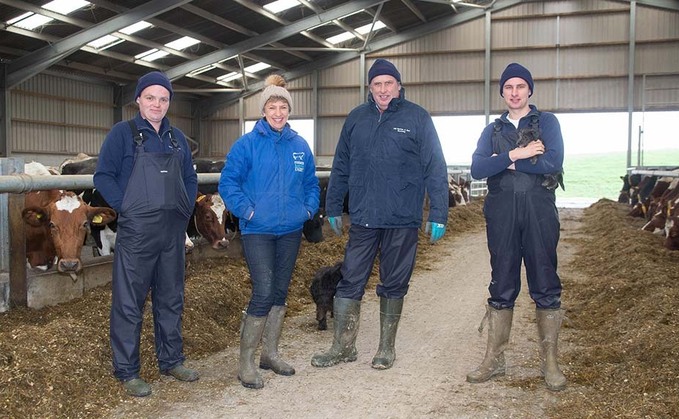
Investing in a new setup on a greenfield site has demonstrated the Barnes family's commitment to dairying for the next generation and beyond. Clemmie Gleeson finds out more.
When Harry Barnes decided to come home and work in the family business, it marked the fourth generation at Alma Bank Farm and signalled major changes for his family and their longstanding dairy herd.
Until then Harry's parents, Mark and Jane, had been contemplating the future of their Ayrshire herd.
Being in the centre of Somerby village, near Melton Mowbray, had its challenges, not least with access for milk tankers, and they had recognised that a new build on land outside of the village was a potential option.
But it was important that Harry was on board.
Mark says: "We needed Harry to want to do it. We wouldn't have done it if it was just us."
The farm was first established when Mark's grandfather moved to Somerby in 1930. He took on a 105-hectare (260-acre) rented farm, before buying the neighbouring Alma Bank Farm, spanning 89ha (220 acres), some 15 years later.
Access
"It was a typical village farm but as the village changed over the years, it created a bottleneck with just a narrow lane," Mark says.
"Access for the milk tanker was getting worse and worse."
Harry went to Brymore Academy in Somerset, a school which has its own farm, and then onto Reaseheath College where he studied for a Level 3 extended diploma in agriculture where his studies included a sandwich year spent gaining practical experience.
Harry says: "It was great experience working for two different dairy farms.
"One was a very intensive high-yielding herd, while the other was grass-based with spring calving."
His confidence grew with the new experiences and even more so when his parents left him in charge of the family herd for three weeks while they went on an Ayrshire trip to the US.
This culminated in Harry deciding he definitely wanted to come home after college.
"With the greenfield site, we knew we had a massive opportunity to build something bespoke"
Jane Barnes
Options
But it was not before the family had gone through a process of assessing their options, briefly contemplating switching to beef production, before recognising that their hearts were very much with dairying.
Jane says: "Our land is only suited to grazing animals.
"Both Mark and I are from dairy backgrounds but we tried to leave it up to Harry to make a decision. We are all passionate about cows and nothing else has the same effect on us."
Harry insists the decision was not based purely on the emotional ties with dairying generally and the Somerby herd in particular.
Harry says: "I don't believe it would stack up to have suckler cows instead."
Their milk buyer, a local cheesemaker, was also extremely keen for them to continue dairy farming.
Once the decision was made, the next step was to decide on details for the new dairy and particularly important was to address issues they had had with the old site which included a lack of space, the handling of slurry and also having enough space for feeding.
Jane says: "We were milking 150 cows at that point and bursting at the seams.
"Nothing was big enough - the silage clamp, the slurry pit, or the cubicles. With the greenfield site, we knew we had a massive opportunity to build something bespoke."
They chose cubicle housing with a central feed passage.
Mark says: "It's just a two row system and we wanted an internal feed passage because the passageway was never wide enough at the old farm."
The family initially thought they wanted to use sand in the housing, but changed their minds after visiting farms who had struggled with it, saying that it did not really work with slurry channels. Instead, they opted for sawdust which is working well.
Harry says: "We used straw before and found it hard to keep things clean, so it was important to make the right choice in the new housing."
The family had their own design for the dairy ready when they approached a quantity surveyor and builder to work on the project.
Jane says: "They were both from a dairy background so were able to give their input.
"This was particularly helpful with slurry management."
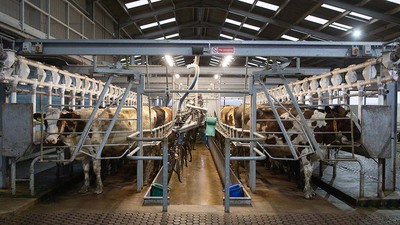
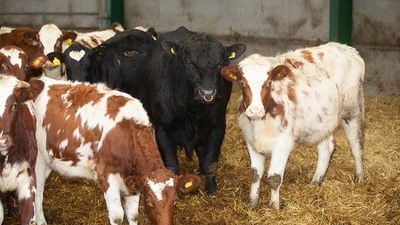
The replacement heifers running with the bull.
Completed
The new farm was completed in 2018 and the cows started milking in the new parlour that November.
At the same time, the family purchased 70 in-calf heifers to help bring numbers up, meaning they were milking more than 200 cows in the new parlour from the start.
Harry says: "We wanted the new milking parlour to be simple. The old one was a nightmare with the electrics and cost a lot to run. This one has low running costs and low maintenance."
The parlour of choice was a Waikato Herringbone 24:48 with automatic cluster removal, automatic wash, soft start and a variable vacuum.
The new set up has also enabled Jane to pursue her passion for education.
She says: "We were in Countryside Stewardship until 2014 which included educational visits from schools. There was lots of interest so I asked if I could also do adult visits as well. We had 30 to 40 visits per year which were all paid for."
Jane was also frequently booked as a guest speaker for groups such as The Women's Institute, giving about 100 talks a year.
She says: "I called it ‘Tales of a Dairy Farmer's Wife' and tried to be educational and entertaining."
The old farm, however, had no facilities for people to watch cows being milked.
"The only way to make it possible was to create space by running the parlour at half capacity which was less than ideal," says Jane.
"In contrast the new parlour is 74ft long with enough space for a 40ft, high-specification, fully insulated classroom alongside it. Two viewing windows into the parlour means that people can sit in comfort and watch cows being milked.
"We also have a balcony so they can see, hear and smell everything without interfering with the process. It's been brilliant."
The classroom was finished in April 2019, and the farm is also able to offer farm tours.
"My father made me a lovely trailer to tow behind a tractor to take visitors around the farm," Jane says.
So, we did a trailer tour. Visitors would see the cows, visit the calves and finish off with tea and cake in the classroom. I had 20 groups in the first year. It went really well and covered the costs of building the classroom."
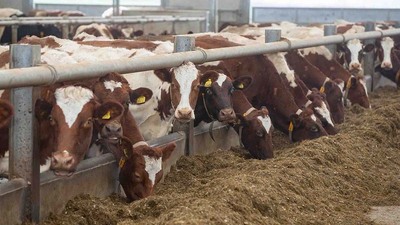
The herd consists of 270 cows, made up of Ayrshires and Friesian crosses.
Adapting
When Covid-19 related restrictions hit initially, all visits were put on hold until August, although the farm has since adapted.
Jane says: "A local lady asked if she could bring her grandchildren while they were staying with her, which gave me the idea to hold visits for individual families to be Covid compliant. So we have managed to keep going; from that I have also started a toddler group."
With the success of the new site and their expansion the next steps are to fine tune the herd and its performance, a challenge that Harry is looking forward to.
As part of a discussion group with other likeminded dairy farmers he is keen to use benchmarking to measure herd performance and improvements.
Mark and Jane remain great enthusiasts for the Ayrshire breed, but they are also excited to see Harry make his own way with the business.
Harry is very interested in Friesians which he believes will suit their system better and maximise milk from forage.
He says: "The 70 heifers we bought in were Friesian crosses and we are now transitioning to cross breeding Friesians and Ayrshires."
Another upcoming change is a move to autumn block calving, set to be in place by 2022, instead of the current split spring and autumn calving system which suited the previous set-up.
Future plans for the farm more generally are based on expansion alongside efforts to improve, says Harry.
"We need to make more forage before we can grow the herd much more," says Harry.
With this in mind, 24ha (60 acres) of grass has been re-seeded with a view to to producing some better quality forage.
The family also decided to outsource maize growing for the first time in 2020, with a local grower producing it and delivering it to the clamp.
Harry says: "We had been growing maize on our best land, but we needed to increase our grazing platform so we put that all down to grass instead.
"I want to invest in the infrastructure now for stability and a long-term future in dairying for my generation and beyond."
Jane remains committed to her educational visits and speaking engagements while Mark is looking forward to a better work-life balance with Harry on board and taking increasing responsibility.
Jane says: "Mostly we are looking forward to Covid-19 restrictions ending, getting to one calving block by 2022 and being able to book a holiday."
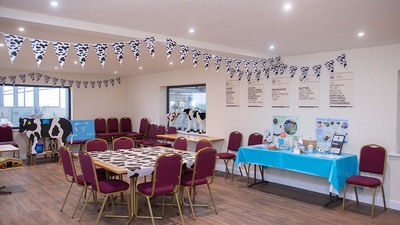
The education centre at the farm.
Farm facts
- Fourth generation family farm founded in 1930
- Somerby herd now stands at 270 cows in-milk
- Ayrshires and some Friesian crosses
- Milk all sold to local cheese-maker
- Classroom and trailer for educational visits
- Average yields 6,000litres/year
- Typical milk solids 4.45 per cent butterfat 3.6 per cent protein
- New cubicle shed and parlour (adjoining) built in 2018 measure 70ft by 220ft and 110ft by 220ft covering 0.5ha (1.3 acres) and new youngstock shed 95ft by 120ft with centre feed passage





